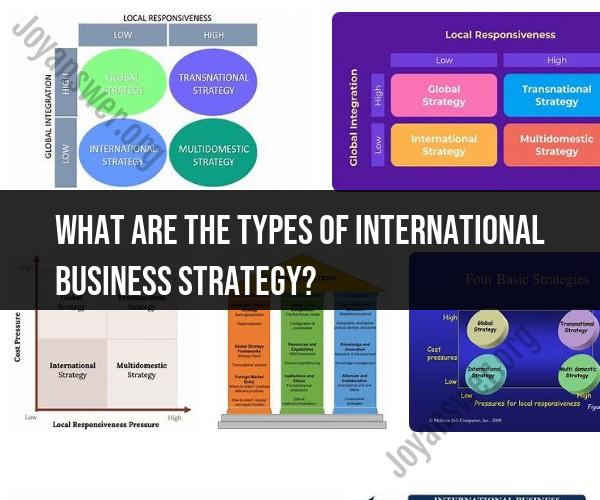What are the types of international business strategy?
International business strategies are approaches that organizations use to expand their operations and conduct business in foreign markets. These strategies can vary based on a company's goals, resources, and the specific market conditions they are entering. Here are some common types of international business strategies:
Exporting:
- Direct Exporting: Selling products directly to foreign customers or distributors.
- Indirect Exporting: Using intermediaries like export agents or trading companies to sell products in foreign markets.
Licensing and Franchising:
- Licensing: Allowing a foreign entity to use your intellectual property, such as patents, trademarks, or technology, in exchange for fees or royalties.
- Franchising: Granting foreign businesses the right to operate under your brand name and business model in exchange for fees or a percentage of their revenue.
Joint Ventures:
- Joint ventures involve partnering with a local company in the foreign market to create a new business entity. Both partners share ownership, risks, and profits.
Strategic Alliances and Partnerships:
- Strategic alliances involve forming partnerships with foreign companies for mutual benefit without creating a new entity. This can include cooperative research, marketing agreements, or joint product development.
Foreign Direct Investment (FDI):
- FDI involves establishing wholly-owned subsidiaries, branches, or manufacturing facilities in foreign countries. This gives the company complete control but can be resource-intensive and risky.
Mergers and Acquisitions (M&A):
- Mergers involve combining with a foreign company to create a new entity, while acquisitions involve purchasing an existing foreign company. These strategies can provide quick market access and access to established customer bases.
Global Standardization:
- A global standardization strategy focuses on offering standardized products or services across different markets, often with minimal customization. This approach can lead to cost savings but may not always align with local preferences and needs.
Localization or Adaptation:
- Localization strategies involve customizing products, services, and marketing to meet the specific needs and preferences of each foreign market. This approach can enhance market acceptance but may be resource-intensive.
Transnational Strategy:
- A transnational strategy seeks to balance global standardization and local adaptation by creating a flexible and integrated approach. This allows a company to leverage global scale while meeting local market requirements.
Geographical Diversification:
- This strategy involves expanding into multiple foreign markets to reduce risks associated with dependence on a single market.
Market Niche Strategy:
- Focusing on a specific niche market or segment within foreign markets can be a strategy, especially for companies with unique products or specialized expertise.
E-commerce and Online Expansion:
- Leveraging e-commerce platforms to sell products or services internationally has become a common strategy for businesses in the digital age.
The choice of which international business strategy to pursue depends on factors such as a company's goals, financial resources, risk tolerance, and the nature of the foreign markets they wish to enter. It's essential for organizations to conduct thorough market research and consider the unique challenges and opportunities of each international market they target.
Exploring Global Business: Common Types of International Business Strategies
There are four main types of international business strategies:
- International strategy: This is the simplest type of international strategy, and it involves exporting or importing goods and services. Companies that use this strategy typically focus on a few specific markets and tailor their products or services to meet the needs of those markets.
- Multidomestic strategy: This strategy involves adapting products and services to the specific needs of each market that a company enters. This can be a more complex and expensive strategy than the international strategy, but it can also be more successful in markets where there are significant cultural or economic differences.
- Global strategy: This strategy involves standardizing products and services across all markets. This can be the most efficient and cost-effective strategy, but it can also be the riskiest, as it assumes that customers in all markets will have the same needs and preferences.
- Transnational strategy: This strategy is a hybrid of the global and multidomestic strategies. Companies that use this strategy standardize their products and services to some extent, but they also adapt them to meet the specific needs of each market. This is the most complex and expensive strategy, but it can also be the most successful.
The best international business strategy for a company will depend on a number of factors, including the company's size, industry, resources, and target markets.
Navigating the Global Marketplace: Strategies for International Business Success
There are a number of strategies that companies can use to succeed in the global marketplace. These include:
- Conducting thorough market research: It is important to understand the markets that you are entering, including the cultural, economic, and competitive landscape.
- Building relationships with local partners: Local partners can help you to navigate the local market and build relationships with customers and suppliers.
- Adapting your products and services to local needs: As mentioned above, it is important to adapt your products and services to the specific needs of each market. This may involve changes to the product design, packaging, marketing, or distribution channels.
- Protecting your intellectual property: It is important to protect your intellectual property in the markets that you are entering. This may involve registering trademarks and patents.
International Business Expansion: Choosing the Right Strategy for Your Company
When choosing an international business expansion strategy, there are a number of factors to consider, including:
- Your company's goals: What do you hope to achieve by expanding internationally? Do you want to increase sales, market share, or brand awareness?
- Your company's resources: What resources do you have available to support international expansion? This includes financial resources, human resources, and technological resources.
- Your target markets: Which markets do you want to enter? What are the cultural, economic, and competitive conditions in those markets?
- Your company's products or services: Are your products or services suitable for international markets? Do you need to make any changes to them?
Once you have considered all of these factors, you can choose the international business expansion strategy that is right for your company.
It is important to note that there is no one-size-fits-all approach to international business. The best strategy for one company may not be the best strategy for another company. It is important to choose a strategy that is tailored to your company's specific needs and goals.













